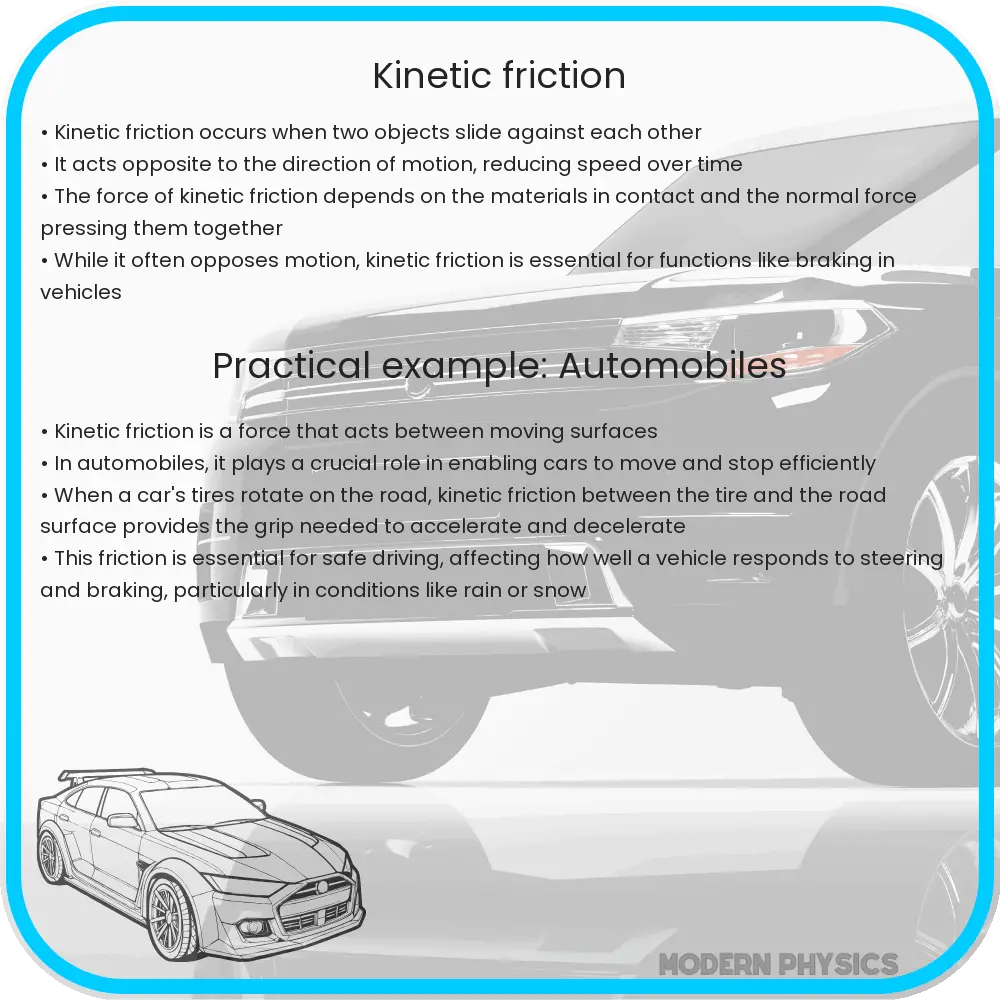Explore the essentials of kinetic friction: its factors, calculations, and impact on statics, with practical applications in various industries.

Understanding Kinetic Friction: An Essential Guide
Kinetic friction, often referred to as sliding friction or dynamic friction, is a force that occurs when two surfaces move relative to each other. This phenomenon plays a crucial role in everyday life, from the working of machinery to the simple act of walking. Understanding the factors influencing kinetic friction, its calculation, and its relationship with static friction is essential for anyone involved in physics, engineering, and various practical applications.
Factors Influencing Kinetic Friction
The magnitude of kinetic friction depends on several key factors:
- Nature of Surfaces: The roughness or smoothness of the contacting surfaces significantly impacts the amount of friction generated. Rougher surfaces with more irregularities typically result in higher friction.
- Normal Force: This is the force perpendicular to the surfaces in contact. In simple terms, it’s usually the weight of the object. The greater the normal force, the higher the friction.
- Material Properties: Different materials have different intrinsic properties that affect friction. For example, rubber on concrete generates more friction than ice on steel.
Calculating Kinetic Friction
Kinetic friction is calculated using the formula:
Fk = μk × N
Where:
Fkrepresents the kinetic friction force,μkis the coefficient of kinetic friction, a dimensionless constant that depends on the materials in contact,Nis the normal force.
The coefficient of kinetic friction is typically determined experimentally and varies for different material pairs under specific conditions.
Static vs. Kinetic Friction
Understanding the difference between static and kinetic friction is crucial. Static friction occurs when an object is at rest, and it must be overcome to start moving the object. Once the object is in motion, kinetic friction takes over. Generally, static friction is higher than kinetic friction for the same set of surfaces. This difference explains why it’s often harder to start moving an object than to keep it moving.
The interplay between these two types of friction has significant implications in various fields, from automotive engineering to the design of sports equipment. In the next section, we will delve deeper into these applications and explore how the principles of kinetic friction are applied in real-world scenarios.
Real-World Applications of Kinetic Friction
The principles of kinetic friction are not just theoretical concepts but have practical applications in various fields:
- Automotive Industry: Understanding kinetic friction is crucial in designing braking systems. The friction between the brake pads and the wheels needs to be sufficiently high to stop the vehicle effectively.
- Sports Equipment Design: The design of sports shoes, like soccer cleats or running spikes, depends heavily on the principles of kinetic friction to provide athletes with the necessary grip.
- Manufacturing Processes: In manufacturing, controlling friction is vital for the efficient functioning of machinery and the quality of the final products.
Impact of Statics on Kinetic Friction
The field of statics, which deals with forces in equilibrium, also plays a significant role in understanding kinetic friction. The principles of statics help in calculating the normal force, which is a key component in determining frictional forces. For instance, in an inclined plane scenario, statics principles are used to resolve forces and calculate the normal force, which is not merely the weight of the object but a component of it.
Conclusion
Kinetic friction is a fundamental force that impacts our daily lives and various industrial processes. The factors influencing it, such as the nature of surfaces, normal force, and material properties, dictate its magnitude and hence its effects. Calculating kinetic friction involves understanding these factors and applying the appropriate formula. Furthermore, the distinction between static and kinetic friction is crucial for practical applications. Whether it’s in automotive braking systems, sports equipment design, or manufacturing processes, the principles of kinetic friction are integral. Understanding and harnessing this force is key to innovation and efficiency in multiple domains. In conclusion, the study of kinetic friction not only enriches our knowledge of physics but also empowers us to create better, more efficient systems and technologies.
